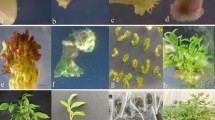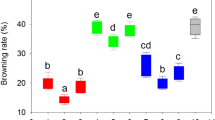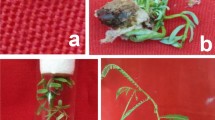Abstract
Waterhemp (Amaranthus tuberculatus (Moq.) Sauer) is one of the most problematic weeds in the Midwestern agricultural systems in the USA. As a consequence of extensive herbicide selection pressure, many waterhemp populations across the USA evolved resistance to multiple herbicides, leading to limited options for chemical control. Genome editing tools, including CRISPR/Cas9, have great potential in weed science, especially when coupled with a gene drive system for a sustainable weed management. The application of modern biotechnological tools requires availability of an efficient regeneration and genetic transformation system. The objectives of this research were to develop an efficient protocol for successful regeneration of waterhemp via callus culture and optimize an Agrobacterium-mediated transformation method for waterhemp. Hypocotyl explants cultured on callus induction medium (CIM), C6 containing 1.0 mg L−1 kinetin and 4.0 mg L−1 2,4-D for 2 wk followed by subculture into shoot induction medium (SIM), S8 containing 3.0 mg L−1 BAP, 0.05 mg L−1 2,4-D, and 0.3 mg L−1 GA3 for 4 to 6 wk was successful in shoot regeneration. Leaf explants failed to respond to any treatment combinations tested for regeneration. Using the hypocotyl explant–based regeneration protocol optimized in this research, Agrobacterium-mediated transformation was performed using uidA and hpt genes as a proof of concept. Although transgenic plants were not regenerated, molecular characterization of the transformed calluses confirmed the presence of transgenic genes, for example uidA and hpt. This is the first report of the tissue-cultured-based regeneration and Agrobacterium-mediated transformation of hypocotyl derived calluses in waterhemp, which is a step forward in exploring the possibilities of genome editing research in weed science.



Similar content being viewed by others
References
Al-Khayri JM, Huang FH, Morelock TE, Busharar TA (2019) Stimulation of shoot regeneration in spinach callus by gibberellic acid. HortScience 27:1046
Bagga S, Venkateswarlu K, Sopory SK (1987) In vitro regeneration of plants from hypocotyl segments of Amaranthus paniculatus. Plant Cell Rep 6:183–184
Banno H, Ikeda Y, Niu Q-W, Chua N-H (2001) Overexpression of Arabidopsis ESR1 induces initiation of shoot regeneration. Plant Cell 13:2609–2618
Barrett LG, Legros M, Kumaran N, Glassop D, Raghu S, Gardiner DM (2019) Gene drives in plants: opportunities and challenges for weed control and engineered resilience. Proc R Soc B Biol Sci 286:20191515
Bell MS, Hager AG, Tranel PJ (2013) Multiple resistance to herbicides from four site-of-action groups in waterhemp (Amaranthus tuberculatus). Weed Sci 61:460–468
Bennici A, Grifoni T, Schiff S, Bovelli R (1997) Studies on callus growth and morphogenesis in several species and lines of Amaranthus. Plant Cell Tiss Org Cult 49:29–33
Bennici A, Schiff S (1997) Micropropagation of Amaranthus (Amaranth). In: Bajaj YPS (ed) High-tech and micropropagation V. Springer, Berlin Heidelberg, Berlin, Heidelberg, pp 20–29
Bensch CN, Horak MJ, Peterson DE (2003) Interference of redroot pigweed (Amaranthus retroflexus), Palmer amaranth (A. palmeri), and common waterhemp (A. rudis) in soybean. Weed Sci 51:37–43
Bouchabke-Coussa O, Obellianne M, Linderme D, Montes E, Maia-Grondard A, Vilaine F, Pannetier C (2013) Wuschel overexpression promotes somatic embryogenesis and induces organogenesis in cotton (Gossypium hirsutum L.) tissues cultured in vitro. Plant Cell Rep 32:675–686
Bradley K, Nordby D, Hartzler B (2022) Biology and management of waterhemp. The Glyphosate, Weeds and Crops Series 13. Purdue Extension pp 1–12
Brenner DM, Johnson WG, Sprague CL, Tranel PJ, Young BG (2013) Crop–weed hybrids are more frequent for the grain amaranth ‘Plainsman’than for ‘D136-1’. Genet Resour Crop Evol 60:2201–2205
Chen H, Nelson RS, Sherwood JL (1994) Enhanced recovery of transformants of Agrobacterium tumefaciens after freeze-thaw transformation and drug selection. Biotechniques 16:664–668
Duke SO (2012) Why have no new herbicide modes of action appeared in recent years? Pest Manag Sci 68:505–512
Economou AS, Spanoudaki MJ (1986) The influence of cytokinins and gibberellic acid on gardenia tissue cultures. Sci Hortic 29:155–161
Esvelt KM, Gemmell NJ (2017) Conservation demands safe gene drive. PLoS Biol 15:e2003850
Franssen AS, Skinner DZ, Al-Khatib K, Horak MJ, Kulakow PA (2001) Interspecific hybridization and gene flow of ALS resistance in Amaranthus species. Weed Sci 49:598–606
Gaines TA, Duke SO, Morran S, Rigon CA, Tranel PJ, Küpper A, Dayan FE (2020) Mechanisms of evolved herbicide resistance. J Biol Chem 295:10307–10330
Green JM (2012) The benefits of herbicide-resistant crops. Pest Manag Sci 68:1323–1331
Green JM, Owen MDK (2011) Herbicide-resistant crops: utilities and limitations for herbicide-resistant weed management. J Agric Food Chem 59:5819–5829
Harker KN, O’Donovan JT (2013) Recent weed control, weed management, and integrated weed management. Weed Technol 27:1–11
Hartzler B (2019) Waterhemp: a “friendly” native evolves into the Cornbelt’s worst weed problem. Iowa State Univ Ext Outreach Integr Crop Manag 11. Available https://crops.extension.iastate.edu/blog/bob-hartzler/waterhemp-friendly-native-evolvescornbelts-worst-weed-problem. Accessed 3 Dec 2023
Hasanuzzaman M, Mohsin SM, Bhuyan MB, Bhuiyan TF, Anee TI, Masud AA, Nahar K (2020) Phytotoxicity, environmental and health hazards of herbicides: challenges and ways forward. In: Prasad MNV (ed) Agrochemicals detection, treatment and remediation:pesticides and chemical fertilizers. Butterworth-Heinemann, Oxford, pp 55–99
Heap I (2023) Current status of the international herbicide-resistant weed database. Available http://www.weedscience.org. Accessed on 3 Dec 2023
Heidmann I, De Lange B, Lambalk J, Angenent GC, Boutilier K (2011) Efficient sweet pepper transformation mediated by the BABY BOOM transcription factor. Plant Cell Rep 30:1107–1115
Horak MJ, Loughin TM (2000) Growth analysis of four Amaranthus species. Weed Sci 48:347–355
Jha P, Norsworthy JK (2009) Soybean canopy and tillage effects on emergence of Palmer amaranth (Amaranthus palmeri) from a natural seed bank. Weed Sci 57:644–651
Jha P, Reddy KN (2018) The role of herbicide-resistant crops in integrated weed management. In: Zimdahl R (ed) Integrated weed management for sustainable agriculture. Burleigh Dodds Science Publishing, Cambridge, pp 215–224
Jhala AJ, Knezevic SZ, Ganie ZA, Singh M (2014) Integrated weed management in maize. In: Chauhan B, Mahajan G (eds) Recent advances in weed management. Springer, New York. pp 177–196
Jofre-Garfias AE, Villegas-Sepúlveda N, Cabrera-Ponce JL, Adame-Alvarez RM, Herrera-Estrella L, Simpson J (1997) Agrobacterium-mediated transformation of Amaranthus hypochondriacus: light, and tissue-specific expression of a pea chlorophyll a/b-binding protein promoter. Plant Cell Rep 16:847–852
Jugulam M, Shyam C (2019) Non-target-site resistance to herbicides: recent developments. Plants 8:417
Keeley PE, Carter CH, Thullen RJ (1987) Influence of planting date on growth of Palmer amaranth (Amaranthus palmeri). Weed Sci 35:199–204
Kniss AR (2018) Genetically engineered herbicide-resistant crops and herbicide-resistant weed evolution in the United States. Weed Sci 66:260–273
Kong J, Martin-Ortigosa S, Finer J, Orchard N, Gunadi A, Batts LA, Thakare D, Rush B, Schmitz O, Stuiver M, Olhoft P (2020) Overexpression of the transcription factor GROWTH-REGULATING FACTOR5 improves transformation of dicot and monocot species. Front Plant Sci 11:572319
Kumlay AM, Ercisli S (2015) Callus induction, shoot proliferation and root regeneration of potato (Solanum tuberosum L.) stem node and leaf explants under long-day conditions. Biotechnol Biotechnol Equip 29:1075–1084
Lakshmi SG, Raghava Ram NV, Vaidyanathan CS (1979) Differentiation of embryoids and plantlets from shoot callus of sandalwood. Plant Sci Lett 15:265–270
Li J, Meng X, Zong Y, Chen K, Zhang H, Liu J, Li J, Gao C (2016) Gene replacements and insertions in rice by intron targeting using CRISPR–Cas9. Nat Plants 2:1–6
Li Z, Liu Z-B, Xing A, Moon BP, Koellhoffer JP, Huang L, Ward RT, Clifton E, Falco SC, Cigan AM (2015) Cas9-guide RNA directed genome editing in soybean. Plant Physiol 169:960–970
Locy RD, Fisher LC (1985) Plant regeneration from tissue cultures of Amaranthus species. In: Henke RR, Hughes KW, Constantin MJ, Hollaender A, Wilson CM (eds) Tissue culture in forestry and agriculture. Springer US, Boston, p 331
Lowe K, Wu E, Wang N, Hoerster G, Hastings C, Cho MJ, Scelonge C, Lenderts B, Chamberlin M, Cushatt J, Wang L (2016) Morphogenic regulators Baby boom and Wuschel improve monocot transformation. Plant Cell 28:1998–2015
Meng Z-H, Liang A-H, Yang W-C (2007) Effects of hygromycin on cotton cultures and its application in Agrobacterium-mediated cotton transformation. In Vitro Cell Dev Biol - Plant 43:111–118
Misra P, Datta SK (2001) Direct differentiation of shoot buds in leaf segments of white marigold (Tagetes erecta L.). In Vitro Cell Dev Biol - Plant 37:466–470
Mithila JGA (2013) Understanding genetics of herbicide resistance in weeds: implications for weed management. Adv Crop Sci Technol 1:3–5
Montgomery JS, Giacomini DA, Weigel D, Tranel PJ (2020) Male-specific Y-chromosomal regions in waterhemp (Amaranthus tuberculatus) and Palmer amaranth (Amaranthus palmeri). New Phytol 229:3522–3533
Montgomery JS, Sadeque A, Giacomini DA, Brown PJ, Tranel PJ (2019) Sex-specific markers for waterhemp (Amaranthus tuberculatus) and Palmer amaranth (Amaranthus palmeri). Weed Sci 67:412–418
Murashige T, Skoog F (1962) A revised medium for rapid growth and bioassays with tobacco tissue culture. Physiol Plant 15:473–497
Nandula VK, Wright AA, Bond JA, Ray JD, Eubank TW, Molin WT (2014) EPSPS amplification in glyphosate-resistant spiny amaranth (Amaranthus spinosus): a case of gene transfer via interspecific hybridization from glyphosate-resistant Palmer amaranth (Amaranthus palmeri). Pest Manage Sci 70:1902–1909
Neve P (2018) Gene drive systems: do they have a place in agricultural weed? Pest Manage Sci 74:2671–2679
Oye KA, Esvelt K, Appleton E, Catteruccia F, Church G, Kuiken T, Lightfoot SB, McNamara J, Smidler A, Collins JP (2014) Regulating gene drives. Science 345:626–628
Pal A, Swain SS, Das AB, Mukherjee AK, Chand PK (2013) Stable germ line transformation of a leafy vegetable crop amaranth (Amaranthus tricolor L.) mediated by Agrobacterium tumefaciens. In Vitro Cell Dev Biol - Plant 49:114–128
Patzoldt WL, Tranel PJ, Hager AG (2005) A waterhemp (Amaranthus tuberculatus) biotype with multiple resistance across three herbicide sites of action. Weed Sci 53:30–36
Porebski S, Bailey LG, Baum BR (1997) Modification of a CTAB DNA extraction protocol for plants containing high polysaccharide and polyphenol components. Plant Mol Biol Rep 15:8–15
Rode NO, Estoup A, Bourguet D, Courtier-Orgogozo V, Débarre F (2019) Population management using gene drive: molecular design, models of spread dynamics and assessment of ecological risks. Conserv Genet 20:671–690
Schultz JL, Chatham LA, Riggins CW, Tranel PJ, Bradley KW (2015) Distribution of herbicide resistances and molecular mechanisms conferring resistance in Missouri waterhemp (Amaranthus rudis Sauer) populations. Weed Sci 63:336–345
Schütte G, Eckerstorfer M, Rastelli V, Reichenbecher W, Restrepo-Vassalli S, Ruohonen-Lehto M, Saucy AG, Mertens M (2017) Herbicide resistance and biodiversity: agronomic and environmental aspects of genetically modified herbicide-resistant plants. Environ Sci Eur 29:1–12
Sekioka TT, Tanaka JS (1981) Differentiation in callus-cultures of cucumber (Cucumis sativas l). Hort Sci 16:451
Shergill LS, Barlow BR, Bish MD, Bradley KW (2018) Investigations of 2,4-D and multiple herbicide resistance in a Missouri waterhemp (Amaranthus tuberculatus) population. Weed Sci 66:386–394
Steckel LE, Sprague CL (2004) Common waterhemp (Amaranthus rudis) interference in corn. Weed Sci 52:359–436
Storkey J, Helps J, Hull R, Milne AE, Metcalfe H (2021) Defining integrated weed management: a novel conceptual framework for models. Agron 11:747
Subhani A, El-ghamry AM, Changyong H, Jianming X (2000) Effects of pesticides (herbicides) on soil microbial biomass-a review. Pakistan J Biol Sci 3:705–709
Sun Y, Zhang X, Wu C, He Y, Ma Y, Hou H, Guo X, Du W, Zhao Y, Xia L (2016) Engineering herbicide-resistant rice plants through CRISPR/Cas9-mediated homologous recombination of acetolactate synthase. Mol Plant 9:628–631
Svitashev S, Young JK, Schwartz C, Gao H, Falco SC, Cigan AM (2015) Targeted mutagenesis, precise gene editing, and site-specific gene insertion in maize using Cas9 and guide RNA. Plant Physiol 169:931–945
Swain SS, Sahu L, Barik DP, Chand PK (2010) Agrobacterium × plant factors influencing transformation of “Joseph’s coat” (Amaranthus tricolor L.). Sci Hortic 125:461–468
Swanton CJ, Weise S (1991) Integrated weed management: the rationale and approach. Weed Technol 5:657–663
Thapa R, Edwards M, Blair MW (2021) Relationship of cultivated grain amaranth species and wild relative accessions. Genes 12:1849
Tranel PJ (2021) Herbicide resistance in Amaranthus tuberculatus. Pest Manag Sci 77:43–54
van Bruggen A, MM H, Shin K, Mai V, Jeong KC, Finckh MR, Morris Jr JG (2018) Environmental and health effects of the herbicide glyphosate. Sci Total Environ 616–617:255–268
Vencill WK, Nichols RL, Webster TM, Soteres JK, Mallory-Smith C, Burgos NR, Johnson WG, McClelland MR (2012) Herbicide resistance: toward an understanding of resistance development and the impact of herbicide-resistant crops. Weed Sci 60:2–30
Werle R, Sandell LD, Buhler DD, Hartzler RG, Lindquist JL (2014) Predicting emergence of 23 summer annual weed species. Weed Sci 62:267–279
Wetzel DK, Horak MJ, Skinner DZ, Kulakow PA (1999) Transferal of herbicide resistance traits from Amaranthus palmeri to Amaranthus rudis. Weed Sci 47:538–543
Wilmink A, Dons JJM (1993) Selective agents and marker genes for use in transformation of monocotyledonous plants. Plant Mol Biol Rep 11:165–185
Wong ACS, Massel K, Lam Y, Hintzsche J, Chauhan BS (2022) Biotechnological road map for innovative weed management. Front Plant Sci 13:887723
Ye S, Cai C, Ren H, Wang W, Xiang M, Tang X, Zhu C, Yin T, Zhang L, Zhu Q (2017) An efficient plant regeneration and transformation system of ma bamboo (Dendrocalamus latiflorus Munro) started from young shoot as explant. Front Plant Sci 8:1298
Zarea MJ, Karimi N (2012) Effect of herbicides on earthworms. Dyn Soil, Dyn Plant 6:5–13
Zhang R, Liu J, Chai Z, Chen S, Bai Y, Zong Y, Chen K, Li J, Jiang L, Gao C (2019) Generation of herbicide tolerance traits and a new selectable marker in wheat using base editing. Nat Plants 5:480–485
Author information
Authors and Affiliations
Corresponding author
Ethics declarations
Conflict of interest
The authors declare no competing interests.
Supplementary Information
Below is the link to the electronic supplementary material.
Rights and permissions
Springer Nature or its licensor (e.g. a society or other partner) holds exclusive rights to this article under a publishing agreement with the author(s) or other rightsholder(s); author self-archiving of the accepted manuscript version of this article is solely governed by the terms of such publishing agreement and applicable law.
About this article
Cite this article
Kumam, Y., Trick, H.N., Sharma, V. et al. Establishment of first protocol of hypocotyl-based regeneration and callus transformation in waterhemp (Amaranthus tuberculatus). In Vitro Cell.Dev.Biol.-Plant (2024). https://doi.org/10.1007/s11627-023-10408-7
Received:
Accepted:
Published:
DOI: https://doi.org/10.1007/s11627-023-10408-7




